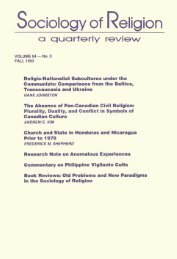The Sources of Gender Role Attitudes among Christian and Muslim ...
The Sources of Gender Role Attitudes among Christian and Muslim ...
The Sources of Gender Role Attitudes among Christian and Muslim ...
Create successful ePaper yourself
Turn your PDF publications into a flip-book with our unique Google optimized e-Paper software.
216 SOCIOLOOY OF RELIGION<br />
<strong>Muslim</strong> affiliation<br />
TABLE 2<br />
OLS ~cients for the Estimated Effects <strong>of</strong> Religion <strong>and</strong> Ethnici~ on<br />
Arab-American Women's Gerder <strong>Role</strong> <strong>Attitudes</strong> (n = 501)<br />
Ethn/c/ty<br />
Duration <strong>of</strong> U.S. residence<br />
Native-bom<br />
Less than 15 years<br />
15 q ca" more<br />
Amb spouse<br />
Amb ethnic organizatiom<br />
Rd/g/os/oj<br />
Belief in scriptural inerrancy<br />
High attendance<br />
Religiosity over the life cycle<br />
Low in childhood <strong>and</strong> adulthood<br />
Dr sime childlxxxt<br />
Increased since chiidhood<br />
Hi$h in childhood <strong>and</strong> aduldxxxt<br />
Bac~ound/'aams:<br />
College education<br />
Children present in home<br />
Age<br />
Age 2<br />
Constant<br />
R 2<br />
Adjusted R 2<br />
+ p = < .10, * p = < .05, ** p - < .01.<br />
<strong>Gender</strong> Traditionalism Index<br />
Model 1 Model 2 Model 3<br />
b Beta b Beta b Beta<br />
1.315"* .195 .498+ .074 -.116 -.017<br />
2.150"* .154 2.185"* .157<br />
1.059"* .159 1.255"* .188<br />
.824** .125 .711"* .108<br />
1.001"* .146 .754** .111<br />
1.767"* .266<br />
.573* .083<br />
n<br />
.616 .058<br />
1.306"* .122<br />
1371"* .193<br />
-1.625"* -.239 -1.239"* -.182 -.523* -.077<br />
.837* .126 .255+ .038 .164 .025<br />
-.015+ .148 -.131+ -.164 -.055+ -.184<br />
.001+ .063 .002+ .359 .001+ .363<br />
8.973 9.616 7.371<br />
.150 .233 .337<br />
.142 .219 .318<br />
Model 2 examines whether the relationship between <strong>Muslim</strong> affiliation <strong>and</strong><br />
gender traditionalism holds when Amb ethnicity is considered. As Model 2 indi-<br />
cates, each dimension <strong>of</strong> Amb ethnicity has a robust Ÿ on women's degree<br />
<strong>of</strong> gender traditionalism- those who ate foreign-bom, married to ah Arab<br />
spouse, <strong>and</strong> share most <strong>of</strong> all <strong>of</strong> their organizational memberships with other<br />
Arabs are significantly more traditional in their gender tole attitudes than ate<br />
those respondents without these ethnic affiliations. Duration <strong>of</strong> U.S. residence is<br />
particularly salient, with the newest arrivals holding the most traditional views.<br />
Importantly, when these dimensions <strong>of</strong> Arab ethnicity ate considered, the<br />
association between <strong>Muslim</strong> affiliation <strong>and</strong> gender traditionalism drops appre-<br />
ciably, both in magnitude <strong>and</strong> significance.<br />
Downloaded from<br />
http://socrel.oxfordjournals.org/<br />
by guest on January 18, 2013



